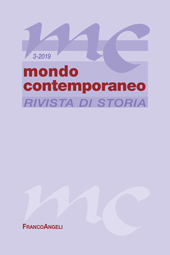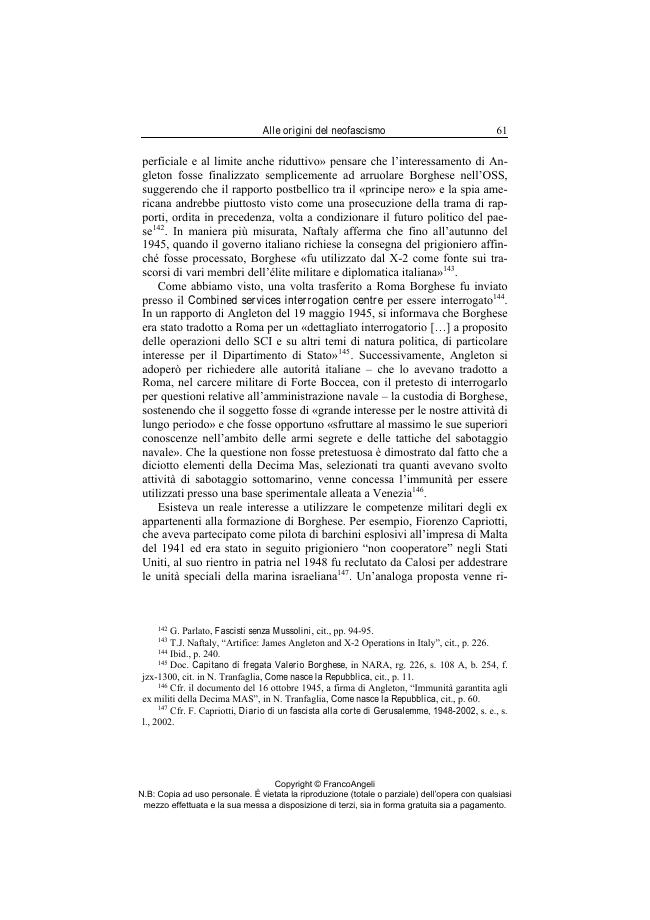Alle origini del neofascismo : la questione della collaborazione con gli Alleati e dell'azione eversiva delle formazioni clandestine (1943-1947) : una rilettura critica
31-91 p.
Esaminando la recente storiografia sul fascismo clandestino, si rileva la presenza di una tendenza banalizzante, che lo interpreta come un fenomeno marginale, e di una opposta tendenza, largamente maggioritaria, drammatizzante, per la quale esso costituirebbe lo strumento principale della battaglia anticomunista combattuta in Italia già negli anni del conflitto, in una sorta di prefigurazione della «strategia della tensione» degli anni Settanta. In questo genere di ricostruzioni, un ruolo rilevante è assegnato ai rapporti occulti tra neofascisti e servizi segreti alleati, in particolare l'Office of strategic services statunitense. Sulla scorta della documentazione disponibile, il saggio ripercorre le vicende del fascismo clandestino, esaminando la sua effettiva consistenza organizzativa e capacità operativa, la sua strategia politica, soffermandosi sulla questione della continuità tra il clandestinismo nel periodo della Rsi e quello postbellico.
econdo l'autore, la tesi di un "disegno" comune tra fascisti e servizi statunitensi non appare supportata da un esame critico delle fonti e che tenga conto delle modalità operative e degli obiettivi strategici dell'Oss in Italia. Le condizioni di estrema difficoltà organizzativa del clandestinismo nel dopoguerra testimoniano l'assenza di qualsiasi sostegno esterno. Nel periodo considerato, l'azione dei gruppi clandestini, lungi dal costituire una minaccia eversiva nei confronti della neonata Repubblica, rappresentò un tentativo di far fronte alla crisi esistenziale e politica dei fascisti e di trovare una collocazione nel nuovo quadro politico. [Testo dell'editore].
In the introduction, the author reviews the recent historiography on clandestine neo-fascism, a phenomenon that arose immediately after the fall of the fascist regime in July 1943 in order to organize a "fascist resistance" in the territory occupied by the Allies. He detects a trend which trivialises it as a marginal and negligible phenomenon, and an opposite one, largely prevailing, which overdramatizes it. According to the latter, clandestine fascism was the main tool of the anticommunist battle fought in Italy start-ing from the war years, in a sort of foreshadowing of the "strategy of tension" of the seventies. In this type of account, an important role is attributed to the hidden relation-ships between neo-fascists and the allied secret services, especially the American Office of Strategic Services. Relying on archival documents, the author reconstructs the history of clandestine fascism, assessing its actual organizational structure, operational effectiveness, and political strategy.
He also addresses the question of continuity between the clandestine fascism of the Repubblica sociale italiana (Italian Social Re-public) and that of the post-war period. In his conclusions, the author argues that the thesis of a «common plan» between the clandestine fascists and the American secret services is not based on a critical analysis of the sources and does not consider the operational patterns of the OSS and its strategic aims in Italy. The organizational problems faced by the clandestine fascists testify to the absence of any external support. In the period observed, the actions of the clandestine fascists, far from representing a subversive threat to the new-born Republic, were an attempt to cope with their existen-tial and political crisis and to find a place in the new political framework. [Publisher's text].
-
Articles from the same issue (available individually)
-
Information
ISSN: 1972-4853
DISCIPLINES
KEYWORDS
- Fascismo clandestino 1943-1947, neofascismo 1943-1947, anticomunismo in Italia 1943-1947, Italia e operazioni stay-behind, Office of strategic services e Italia, Fasci d'azione rivoluzionaria
- Clandestine fascism 1943-1947, Neo-fascism 1943-1947, Anti-communism in Italy 1943-1947, Italy and Stay-behind Operations, Office of Strategic Services in Italy, Fasci d'azione rivoluzionaria



